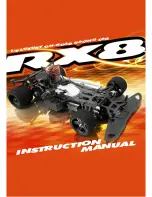
7
Modern R/C cars can use several different types of front
and rear axles. The choice of front and rear axles depends
on track conditions and driving style. You may use any
combination of front and rear axles, but some work better
together than others.
Differentials allow the wheels at opposite ends of the same axle to rotate at different speeds. Why is this
important? When a car turns in a circle, the outer wheel has a larger diameter circle to follow than the
inner wheel, so it needs to rotate faster to keep up. If the differential is too tight, the result is that the wheels
“fight” each other for the proper rotation speed; the result is a loss of traction. Generally, the more grip a
track has, the tighter the diff action should be.
For optimal performance, a ball diff should be as free as possible, with no (minimal) slippage. Make sure
the diff does not slip under power; this causes power loss and excessive wear of the diff.
Depending on the design of the ball differential, the diff may or may not be externally adjustable. Externally-
adjustable ball differentials can be easily adjusted while in the car. This enables very quick changes to the
steering characteristic and overall behavior of the car.
TIGHTER
·
Decreased steering response.
·
More stability under braking, but less turn in.
·
Better on power steering at corner exit.
LOOSER
·
Increased steering response.
·
Less stable under braking but better turn in.
·
Car will understeer on power at corner exit.
A rear differential has the same construction as a front ball differential. A rear differential is a very common choice for the rear axle type, and it
can be combined with all front axle types. Drawbacks of the rear differential are that the weight and inertia are considerably higher than the solid
axle, and more maintenance is required.
effecTS Of reAr BAll DIff ADjUSTmenT
TIGHTER
·
Car understeers slightly at corner entry, but makes the car more difficult to control at corner exit (powerslides).
·
Increased on-throttle steering.
·
Usually better on high-traction surfaces, but may decrease rear end stability at mid corner.
LOOSER
·
More stability mid corner and corner exit.
·
Understeer on-throttle.
·
Better on low-traction surfaces or in conjunction with a front one-way.
BaLL dIFFERENTIaLS
Using a front differential combines some of the braking advantages of the solid front axle while allowing inner-outer wheel speed difference.
A front differential is most commonly used in low grip conditions. It can improve on-power corner entry as well as braking. The front differential is
most commonly used with the rear differential.
On very high traction surfaces, both front and rear diffs can be adjusted tighter for better response.
effecTS Of frOnT BAll DIff ADjUSTmenT
FRONT BaLL dIFFERENTIaL
FRONT & REAR AXlES
REaR BaLL dIFFERENTIaL
Front Axles
Rear Axles
• ball differential
• front one-way axle*
• solid one-way axle*
• solid front axle*
• ball differential
• solid axle
* Modes available in XRAY Multi-Diff™








































